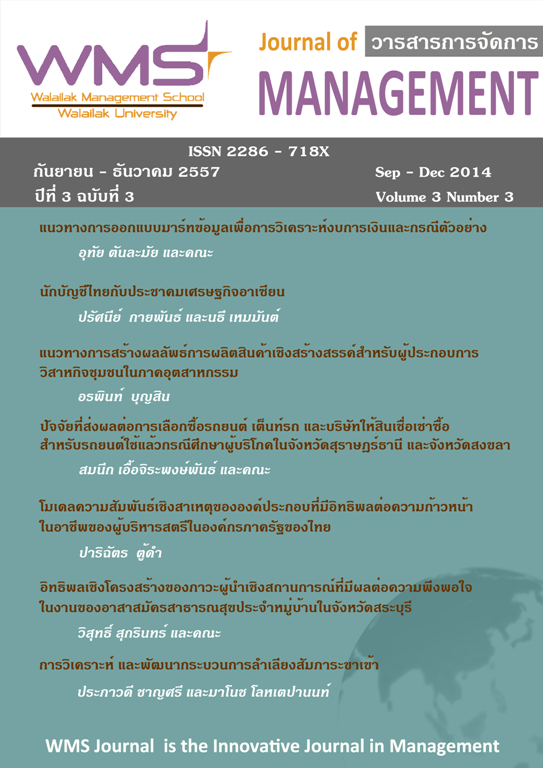Guidelines to Create Production Oriented Enterprise for Community Enterprises in the Industrial Sector
Main Article Content
Abstract
Article Details
References
กรมส่งเสริมอุตสาหกรรม. 2554. รายงานประจำปี 2553 กรมส่งเสริมอุตสาหกรรม: สรรค์สร้างอุตสาหกรรมไทย Creative Industry. กรุงเทพฯ: กรมส่งเสริมอุตสาหกรรม.
ประพนธ์ ผาสุขยืด. 2549. การจัดการความรู้. กรุงเทพฯ: สถาบันส่งเสริมการจัดการความรู้ เพื่อสังคม (สคส.).
วิจารณ์ พานิช. 2548. การจัดการความรู้ในยุคสังคมและเศรษฐกิจบนฐานความรู้. กรุงเทพฯ: สถาบันส่งเสริมการจัดการความรู้เพื่อสังคม.
สำนักงานคณะกรรมการพัฒนาการเศรษฐกิจและสังคมแห่งชาติ (สศช.). (ม.ป.ป.). แผนพัฒนาเศรษฐกิจและสังคมแห่งชาติฉบับที่ 11 (พ.ศ. 2550-2559). กรุงเทพฯ: สำนักงานคณะกรรมการพัฒนาการเศรษฐกิจและสังคมแห่งชาติ.
สำนักงานคณะกรรมการพัฒนาการเศรษฐกิจและสังคมแห่งชาติ (สศช.). 2551. วิสัยทัศน์ประเทศไทยสู่ปี 2570. ใน เอกสารประกอบการประชุมประจำปี 2551 ของ สศช. 15 สิงหาคม 2551 (หน้า 1-26). กรุงเทพฯ: สำนักงานคณะกรรมการพัฒนาการเศรษฐกิจและสังคมแห่งชาติ.
________. 2552. จากวิสัยทัศน์ 2570...สู่แผนฯ 11. สืบค้นเมื่อ 23 เมษายน 2555, สืบค้นจาก http://webcache.googleusercontent.com
สำนักงานเลขาธิการสภาการศึกษา. 2547. การพัฒนาองค์กรและบุคลากรแนวคิดใหม่ในการพัฒนาทรัพยากรบุคคล. กรุงเทพฯ: 21 เซ็นจูรี่.
เสรี พงศ์พิศ. 2546. ฐานคิดจากแผนแม่บทสู่วิสาหกิจชุมชน. กรุงเทพฯ: ร้านรังสีการพิมพ์.
Amir Hosain Amir Khani,Freyedon Ahmadi and Golamhusain Homayouni. 2011. INTERDISCIPLINARY JOURNAL OF CONTEMPORARY RESEARCH IN BUSINESSVOL 2, NO 10
Barney, J.B. 1991. Firm resource and sustained competitive advantage. Journal of Management, 17(1), 99-120
Barney, J. 1997. Gaining and Sustaining Competitive Advantage. MA: Addison-Wesley.
Bontis, N. 2002. Assessing knowledge assets: a review of the models used to measure intellectual capital. International Journal of Management Reviews, 3(1), 41-60.
Carlos Maria Jardon, M Susana Martos,.2012. "Intellectual capital as competitive advantage in emerging clusters in Latin America", Journal of Intellectual Capital, Vol. 13 Iss: 4
Choo, Chun Wei, and Nick Bontis (eds). 2002. Strategic Management of Intellectual Capital and Organizational Knowledge. New York: Oxford University Press.
Constantinescu, M. 2009. Knowledge management: Innovation and productivity laber. Journal of Knowledge Management, 7(1), 7-33.
Edvinsson, L. and Malone, M. S. 1997. Intellectual capital: Realizing your company’s true value
by finding it hidden brainpower. New York: Haper- Collins Publisher.
Hartley, J. 2007. From creative industries to creative economy: flying like a well-thrown bird?’ In J. Hartley (Ed.), Creative Industries (pp. 5-18). Beijing: Tsinghua University Press.
Hsu, H.-Y. 2006. Knowledge Management and Intellectual Capital. Doctor
Dissertation, Department of Philosophy degree in Management, Graduate School, Southern Illinois University Carbondale.
Jyoti Batra. 2010. Knowledge Management: Emerging Practices in IT Industry in NCR. The IUP Journal of Knowledge Management, 8(1, 2), 57-67
Kavida, V., & Sivakoumar, N. 2009. Intelltural: Strategic management. IUP Journal of Knowledge Management, 7(5/6), 55-69.
Lee, C.C. Egbu, C., Boyd,D.,Xiao, H., and chinyo, E. 2005. Knowledge management for small medium enterprise: Capturing and Communication Learning and Experiences. In Proceedings of CIB W99 Working Commission 4.th Triennial International conference rethinking and revitalizing construction. Safeth, health, environment and quality May 2005 (pp.17-20). South Africa: Port Elizabeth.
Meng-Yuh Cheng, Jer-Yan Lin, Tzy-Yih Hsiao, Thomas W. Lin, .2010. "Invested resource, competitive intellectual capital, and corporate performance", Journal of Intellectual Capital, 11(4), 433 – 450
Stewart, T.A. 1997. Intellectual Capital: The New Wealth of Organizations. New York: Double-Day/Currency.
Sullivan, P.H. 2000. Value-driven intellectual capital: How to convert intangible corporate assets into market value. John Wiley & Sons.
Van Buren, M. E. 1999. A yardstick for knowledge management.Training & Development, 53(5), 71-8.
WIPO. 1995. Agreement between the United Nations and the World Intellectual Property Organization. Geneva: WIPO.
UNCTED. 2003. Convention for the Safeguarding of the Intangible Cultural Heritage. Retrieved February 13, 2010, from http://www.unctad.org/creative-economy

